|
CrimeFesting
It has been announced that the 2024 CrimeFest will take place in Bristol from the 9th to 12th May, slightly earlier than usual, and the news reminded me that, in my final regular column, I should pay tribute to my colleagues on Shots, which after all, started life as a print magazine launched at the Shot In The Dark convention in Nottingham in June 1994.
Therefore I will name and shame them using pictures taken at a recent CrimeFest, one of the few remaining public locations where we are allowed to be in the same room together.
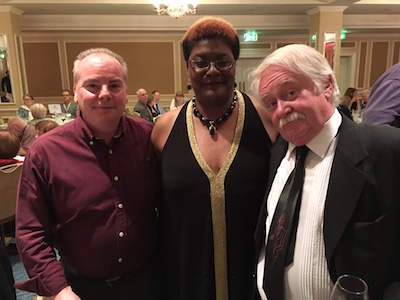 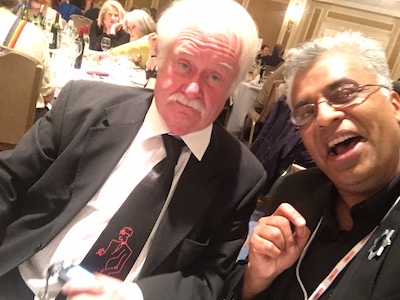
Editor Mike Stotter, Blogspot maven Ayo Onatade and I always presented a discrete and professional approach when rubbing shoulders with the great and good, even with crime writers. With the fourth horseman of the Shots apocalypse, Prince Ali Karim, however, things tended to be more relaxed.
Happy New Year
I have already received a proof of ‘the biggest thriller of 2024’ (it says here) which is published next February by Michael Joseph. Naturally, I could not resist a peek inside The Fury by Alex Michaelides.
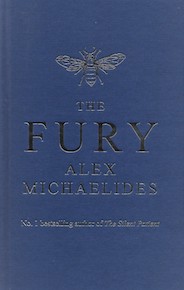
The Prologue begins: Never open a book with the weather. Who was it said that? I can’t remember – some famous writer, I expect.
I am sure the question was rhetorical as it is well-known that the ‘famous writer’ in question was Elmore Leonard who, I suspect, was having a gentle dig at his chum Ed McBain’s habit of starting his 87th Precinct books with the weather. Alex Michaelides probably knew this all along, just as he knew that Elmore Leonard also advised writers never to use a Prologue. (Do I not know what rhetorical means?)
Unexpurgated
Some crime novels achieve notoriety, some have notoriety thrust upon them. One such was Jonathan Latimer’s hard-boiled private eye story known here as Soloman’s Vineyard when published in 1941 after, it is said, being banned in America. Ironically, it became very well-known by young American males who discovered it whilst serving in US forces stationed here during the war. The novel, much censored, eventually appeared in America in 1950 under the author’s preferred title The Fifth Grave.
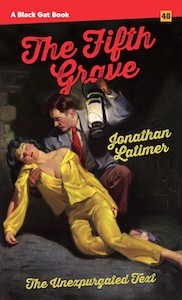 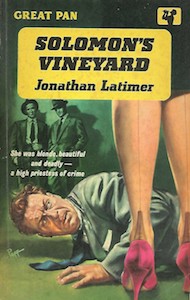
Now those dedicated hard-boildistas at Stark House Press have published – for the first time – an unexpurgated edition in their infamous Black Gat imprint. One of the many blurbs for the original, by John Grant (though probably not the author of the Lovejoy books) calls it ‘a down and dirty tale’ full of ‘hard-boiled swagger’ and claims that Latimer ‘is a rougher Chandler and a funnier Cain or Spillane’.
Word Monkey
I did not know the late Christopher Fowler well. We met only four or five times I think and appeared in public together only once, on a festival panel with M.C. Beaton – so neither of us got much of a word in, though we did get a chance to swap war stories later in the pub after Marion had been whisked away by her chauffeur.
I was familiar with his writing, both his highly imaginative, almost magical, fiction and his regular appreciations of ‘Forgotten Writers’ where I often demanded to be included. Above all, I loved his autobiographical Film Freak about his career in advertising and promoting films; an industry where no-one can hear you scream.
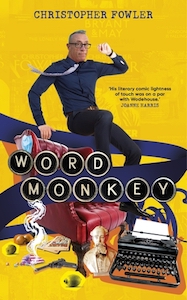
Having been diagnosed with terminal cancer in 2020, Christopher died in March this year but he has left us a deeply moving memorial in the shape of Word Monkey [Doubleday], his reflections on a literary life written knowing that life was coming to an end. This is no ‘misery memoir’ in fact it could not be less of one, cut through with wit, humanity and an obvious love of books.
The scale and the pain of Christopher’s medical misfortunes are not shirked and he clearly found respite in reading a good (or at least familiar) book. He avoided most painkillers other than paracetamol as he reacted to their side-effects because: with blurred vision and a warm fuzz in your head it’s too easy to overdose, drop boiling drinks over yourself, walk into bedroom doors or accidentally read Richard Osman novels...
That one of the epigraphs for the book is a quote from Nigel Molesworth in How To Be Topp says it all.
Size Matters
In his Word Monkey memoir Christopher Fowler, a man who always kept a book handy, makes a forlorn plea for a return to the once common smaller form of paperback which would fit snugly into a jacket pocket without ruining the cut of a gentleman’s jib.
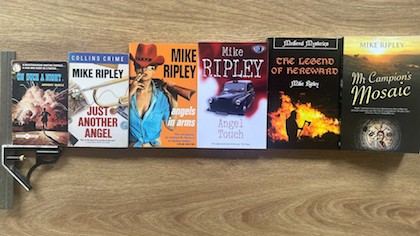
As an experiment, I took half-a-dozen paperbacks purely at random from my shelves to try and chart how they have grown over time. And this is only fiction titles. Non-fiction titles can vary much more.
Cameo
Having seen Christopher Nolan’s superb film Oppenheimer and being thoroughly impressed with Gary Oldman’s cameo as President Harry S. Truman, the thought occurs that as we know Oldman can do Churchill and he’s so good he could surely do Stalin, it would be possible to make a film about the 1945 Potsdam Conference with only one actor.
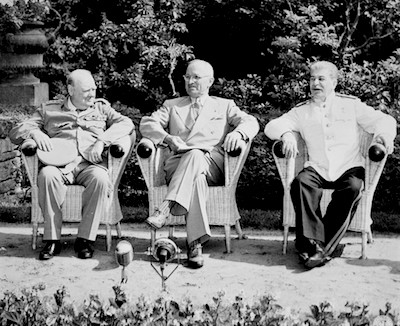
It is an idea I will put to Mr Spielberg should I ever meet him, immediately after pitching the idea of a remake of Sam Peckinpah’s Ride The High Country starring Tom Hanks and George Clooney in the original Joel McCrea/Randolph Scott roles.
Åskbollen
One of the many treats of being a member of the Spybrary Facebook group is that dedicated fans of spy fiction get to share their enthusiasm for their favourite books and their cover art. Until a recent post there, I had never seen the eye-catching covers of Swedish editions of the James Bond novels.
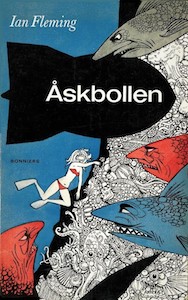
This cover of Thunderball and other equally striking ones was by ‘horror artist’ (as he was known) Hans Arnold, who was born in Switzerland but lived and worked for most of his life in Sweden. Arnold (1925-2010) was also responsible for the artwork on ABBA’s Greatest Hits LP, which I’m sure everyone knew.
Gossip from the Forest
In July I mentioned the origin story of the Getting Away With Murder column at a Sherlock Holmes convention in Crowbridge back in the last century. The multi-award winning author Andrew Taylor (who has more Historical Daggers than Game of Thrones) got in touch to remind me that he too was at that prestigious event and that I gave him, and Harry Keating, a lift to the nearest station when the time came to make our escape. I should have remembered as for months afterwards I would tell all my passengers that I’d had that Andrew Taylor in the back of my cab.
MacLean Double Bill
A double bill of films based on thrillers by Alistair MacLean came to my attention this month; not, of course, an actual double bill which, for younger readers, was once the standard practice in cinemas.
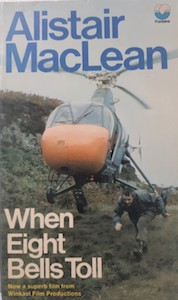
I did not know, though perhaps I should have, until I read in The Times that the 1971 film of Alistair MacLean's When Eight Bells Toll starring Anthony Hopkins, was intended as the first in a planned series of 14 (yes, fourteen) films to feature secret agent Philip Calvert. It was an attempt to rival the Bond franchise, but fell at the first fence.
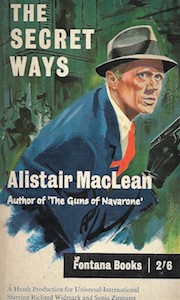
I also discovered that the 1961 film The Secret Ways is available free to watch on something called YouTube. It is a crisp and clear black-and-white print of a film starring (and produced by) Richard Widmark and I just wish it had been better!
Based on Alistair MacLean's 1959 thriller The Last Frontier, which I remember as being jolly exciting, though it is over fifty years since I read it, the spy thriller Secret Ways was released in the UK two months after The Guns of Navarone which overshadowed it to say the least. Nonetheless, the film has some fine shots of 1960 Vienna and the luscious Senta Berger wasted in a minor role. It is probably best remembered for having one of the first film scores to be written by John Williams, plus the fact that the title of the MacLean novel was changed to avoid confusion with the historical novel The Last Frontier by Howard Fast, which was clearly one of the sources for the 1964 western Cheyenne Autumn, which also starred Richard Widmark.
When I pointed this out in a column some years ago, I received a message from the widow of Howard Fast (1914-2003) - an author blacklisted in the McCarthy era for his left-wing views who had to self-publish his novel Spartacus and who wrote good crime fiction as E.V. Cunningham. The producers of Cheyenne Autumn, it seems, decided that there was so much actual history in Fast’s 1941 novel, that it was information in the public domain and therefore refused to buy the rights to The Last Frontier. So the MacLean film could have kept the original title, not, I suspect, that Alistair lost much sleep over the matter as after Navarone just about anything he wrote, even a note to the milkman, would have the film rights snapped up.
Endgame
As I am retiring from this usually upstanding column, I am resigned to the fact that the postman may now only ring once, if at all, to deliver the latest crime fiction. I have already sorted two shelves of books into a To-Be-Read pile, to insure I will not be short of something to read.
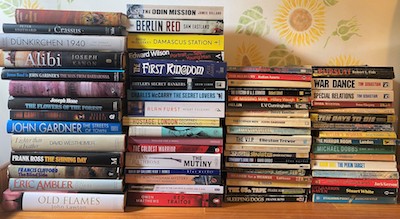

|
|
Books of the Month
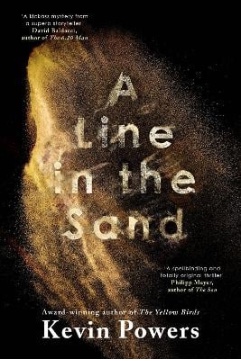
When I see the words ‘literary thriller’ promoting a book, I immediately reach for my pistol, but if it is simply meant to mean well-written, then it certainly applies to A Line in the Sand by Kevin Powers [Sceptre], an absolutely cracking thriller, even if it contains (a few) Americanisms which may distract a British reader, though it won’t be for long. An Iraqi translator with US forces now living an anonymous second life in Virginia finds himself the target of spies and hit-men working for the independent military contractors (think ‘Wagner Group’) because he witnessed atrocities committed by them during the war against Saddam Hussein. As the mercenaries are about to receive a billion-dollar contract from the US Senate, witnesses to past misdeeds have to be eliminated. Standing against them are a washed-up journalist, a splendid career policewoman and a couple of concerned (and well-armed) veterans who all have to draw a line in the sand. Gripping stuff.
Arnold Clover is not your typical fictional detective. In fact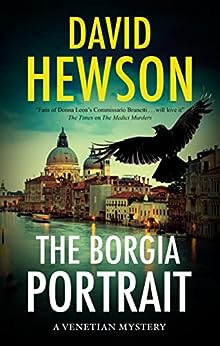 he is not a detective at all, rather a retired British archivist retired to Venice. Nonetheless, in The Borgia Portrait by David Hewson [Severn House] the discovery of a thirty-year-old corpse in a ramshackle palazzo sets him off on a treasure hunt across Venice for a legendary erotic portrait of Lucrezia Borgia, which just might have inspired the equally legendary Casanova. Pursuit of the elusive, extremely valuable if genuine, painting involves solving a series of riddles and clues based on the city’s historic churches, two of which, unusually for Venice where the streets seem permanently flooded, have crypts (though not the one Indiana Jones was in). Clearly, Hewson knows his Venice. He has written about La Serenissima before, but this seems to be a genuine love letter to the parts most tourists never see. If you’ve never been there, take this as a guide book and don’t worry about getting lost in the warren of narrow streets and alleys; that’s half the joy. he is not a detective at all, rather a retired British archivist retired to Venice. Nonetheless, in The Borgia Portrait by David Hewson [Severn House] the discovery of a thirty-year-old corpse in a ramshackle palazzo sets him off on a treasure hunt across Venice for a legendary erotic portrait of Lucrezia Borgia, which just might have inspired the equally legendary Casanova. Pursuit of the elusive, extremely valuable if genuine, painting involves solving a series of riddles and clues based on the city’s historic churches, two of which, unusually for Venice where the streets seem permanently flooded, have crypts (though not the one Indiana Jones was in). Clearly, Hewson knows his Venice. He has written about La Serenissima before, but this seems to be a genuine love letter to the parts most tourists never see. If you’ve never been there, take this as a guide book and don’t worry about getting lost in the warren of narrow streets and alleys; that’s half the joy.
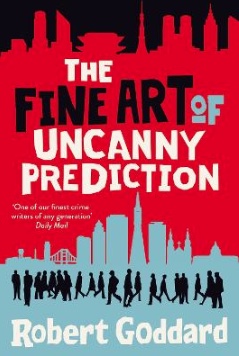
Umiko Wada never set out to be a private detective but as ‘a small, plainly dressed, middle-aged woman with no distinguishing features’ her appearance ‘was a guarantee of total anonymity in a city (Tokyo) where thousands like her could be seen – and ignored – at every turn’. Given the useful advantage of being constantly under-estimated and an iron spine of stubbornness, Umiko actually makes a pretty good detective. In The Fine Art of Uncanny Prediction [Bantam], Robert Goddard gives us a labyrinthine plot involving two inter-connected investigations twenty-five years apart and in fact dating back to the American occupation of Japan after WWII. The ‘uncanny prediction’ of the title refers to the search for ‘the Kobe Sensitive’ – a woman with the knack of predicting earthquakes – a highly prized skill in places prone to them, such as Japan and California, where Umiko’s investigation eventually leads her. Complex, sensitive and finely written; an impressive and totally satisfying crime novel.
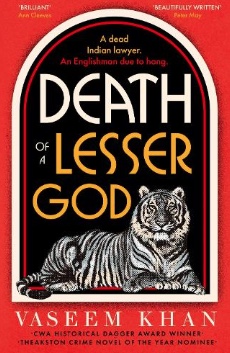
The first female police inspector in the recently independent India, Persis Wadia has enough trouble coping with sexism and religious bigotry in her daily duties at Malabar House, the branch of Bombay’s CID known for being an elephant grave yard for police officers – a place where investigations and careers go to die. In Death of A Lesser God by Vaseem Khan [Hodder] she gets a break from routine, though hardly one she wanted, re-evaluating the murder of an Indian lawyer for which a white Englishman, the son of a rich arch-colonialist has been convicted and is due to hang. The case take Persis back in time to an unsolved double murder and to Calcutta, where gangsters, tigers and crocodiles make Bombay seem positively idyllic. Persis Wadia is a wonderful character, 1950 India is colourfully evoked and there are fascinating nuggets of history, such as the presence of 150,000 American troops in Bengal during WWII and the story of India’s Jewish community, all of which make the novel educational as well as extremely entertaining.
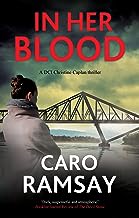
In Her Blood by Caro Ramsay [Severn House] is the second outing for new series heroine DCI Christine Caplan, who comes with enough domestic problems of her own that policing the wild bits of Scotland might come as something of a relief. Not, however, in this case where the main suspect in a murder case is a child-murderer and by that I mean a child who has murdered other children, possibly more than once. Being a minor and although no longer in protective custody, all details of ‘Girl A’ are kept very much under wraps, even from the police working the current murder case. Caplan’s investigation is physically hindered by the desolate local geography but however remote the location, invidious social media nastiness still seems to get through.
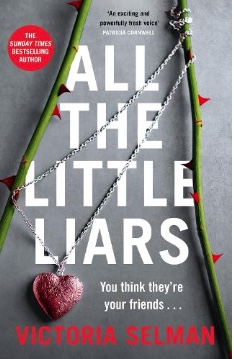
The most reliable thing about crime fiction these days is that the narrator will be unreliable. In All The Little Liars [Quercus] Victoria Selman cunningly pulls the wool over the reader’s eyes as to what actually happened in 2003 when three teenage American girls went to a party out in the woods, but only two returned. There’s a creepy feeling of an ‘I Know What You Did Last Summer Twenty Years Ago’ scenario and there’s a belter of a revelation about half-way through. Then the narrative, now twenty years on and moved to London, does eventually provide a solution to what happened to the missing girl, but after that major sucker-punch falls slightly flat.
Re-issues of the Month
Twenty-five years ago I discovered the pacy, wonderfully seedy and often very funny crime thrillers of Doug J. Swanson and looked forward to many more adventures of his hero, the lawyer-turned-investigator, Jack Flippo. I remember recommending the books to fellow (British) crime writers and even though Swanson’s first novel won the CWA’s John Creasey Award in 1994, I cannot recall any who said they had read him. And after five novels, that seemed to be it.
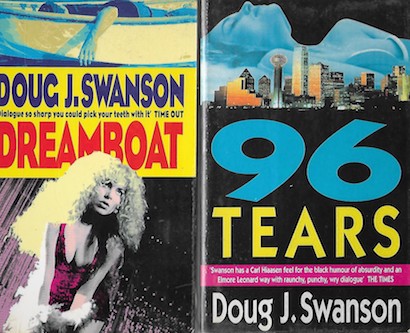
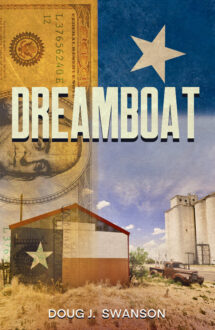 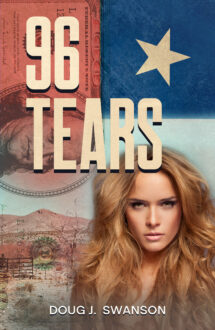
But now those bumptious enthusiasts at Brash Books have done a great service by producing new editions of all five Swanson books and once more I will recommend them and tell anyone who will listen that you heard it here first – again.
Another reissue at the end of the month brings back some very personal memories. Back in 1988, a first novel entitled Just Another Angel was beaten to the CWA’s John Creasey Award by another debutant, Death’s Bright Angel by Janet Neel.
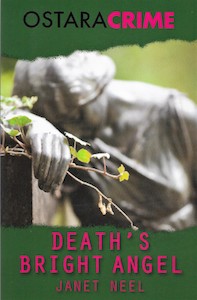
Strangely enough, I became (and remain) good friends with Janet Neel, now Baroness Cohen of Pimlico, edited new editions of her crime novels for the Ostara Crime imprint and even dedicated my new novel (out in September; just thought I’d mention it) to her.
Now Joffe Books are reissuing all seven of her novels to feature her sleuthing duo of Inspector McLeish and Fran Wilson, initially as a ‘box set’ of ebooks.
Museum Muse
This is not the famous Gun Room at Ripster Hall. That, as is well-known, contains the famous collection of 18th-century muskets which are still kept in readiness to be issued to the local Yeomanry in the event of a peasant uprising.
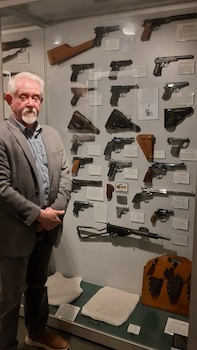
In fact this is a very small part of the display of militaria at the Combined Services Museum in Maldon, Essex where exhibits range from a sword dating to the battle of Maldon (Anglo-Saxons v. Vikings in 991) through to the tools-of-the-trade of SOE agents during WWII and spies of all sides in the Cold War. There is, spookily, a KGB map from the 1960s of East Anglia which even shows Ripster Hall, just one of many plot ideas garnered from my visit.
Cross-overs into the world of fiction occur with exhibits featuring Ian Fleming’s wartime career and a cache of white £5 notes forged by the Nazis in an attempt to undermine the British economy, discovered after the war. It was a plot predicted by Margery Allingham in Traitor’s Purse, which she began writing in 1939, long before the German Operation Bernhard became public knowledge.
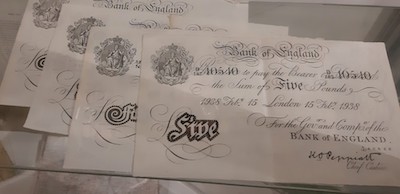
Parting Shots
After two hundred columns, it really is time to thank some of the many people who have helped; or who should at least share the blame.
First and foremost must be Fiona Messenger who, many years ago, was blackmailed into being a sub-editor for Getting Away With Murder and who has worked diligently correcting spelling and grammar and avoiding legal disputes.
Within publishing there are certain publicists who have been both polite and helpful, among them: Patsy Irwin, Ana and Lisa (the Quercus dynamic duo), Felicia Hu, Steven Cooper, Henry Lord, Sophie Portas, Felicity Denham, Alex Hippisley-Cox, Henry Lord, Sophie Ransome, Sally Wray, Sriya Varadharajan, Milly Reid and others I have no doubt forgotten.
There are some I have deliberately forgotten, mainly those who ask me several times a month, for my “best address”. I have tried to persuade them that my best address is the Palazzo Medici Riccardi on the Via Camillio Cavour in Florence. Sadly, I don’t live there.
I will certainly not miss the ‘Zoom meetings’ and ‘online launches’ which seem to have replaced the traditional publishers’ parties in the best of London’s fleshpots since the Covid lock-downs. I even hear that CWA supremo Vaseem Khan (see Books of the Month) had something called ‘a soft launch’ for his new novel, though I wasn’t invited to that either.
I do have one party to look forward to and that has the distinction of being the longest-running celebration for a particular author in crime fiction history. The launch of a new ‘Dick Francis’ novel has been a stand-out event in the social calendar for more than thirty years and I have been privileged to attend most of them. Originally hosted by Dick, and latterly Felix Francis, the September party will see the launch of No Reserve and yet another chance for the worlds of horse racing and crime fiction to mingle, but without the associated jeopardy and violence found on the printed page.
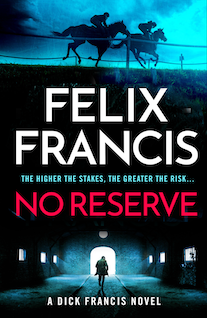 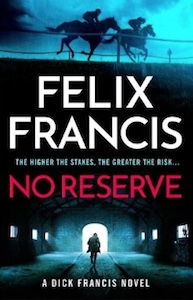
Given that this is my final regular column, I was touched to receive an invitation from Felix which came with the message: Glad you can come as a retired gentleman!!! I will greatly miss your monthly Getting Away with Murder amusement.
I am proud to report that Felix Francis is not the only one who will miss Getting Away With Murder. I long since became immune to complaints that the column was resulting in massive credit card debt, possibly even divorce, due to recommending so many good books, though it has been heart-warming to receive valedictory messages from such fellow scribblers as: Len Deighton, Ian Rankin (Sir/He), Andrew Taylor, Ken Bruen, Jeremy Cameron, Peter Morfoot, Alex Shaw and John Lawton (‘Oh fukk...you were serious!’).
And of course I will miss it, but with an estimated 600 new crime novels and thrillers conventionally published this year, plus possibly an equal number appearing as ebooks or self-published, keeping tabs on them is very much a young man’s game.
When the fun stops, stop.
Ripster.
|